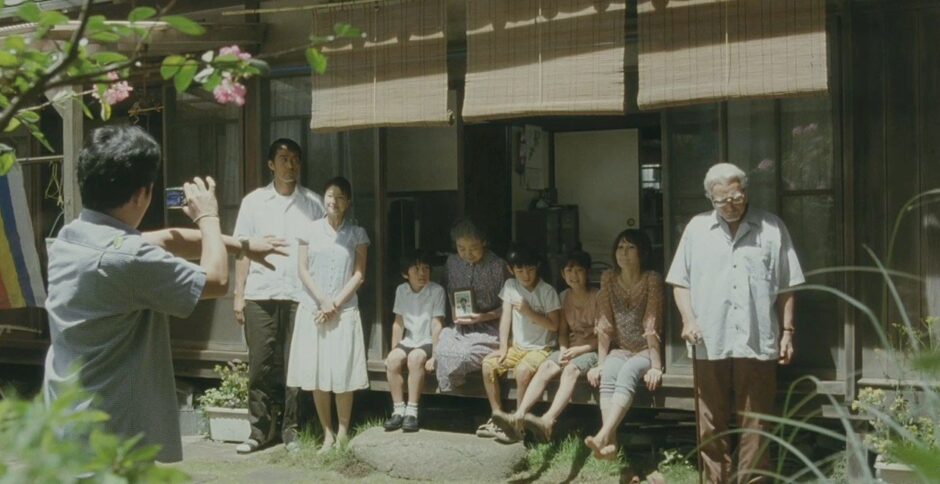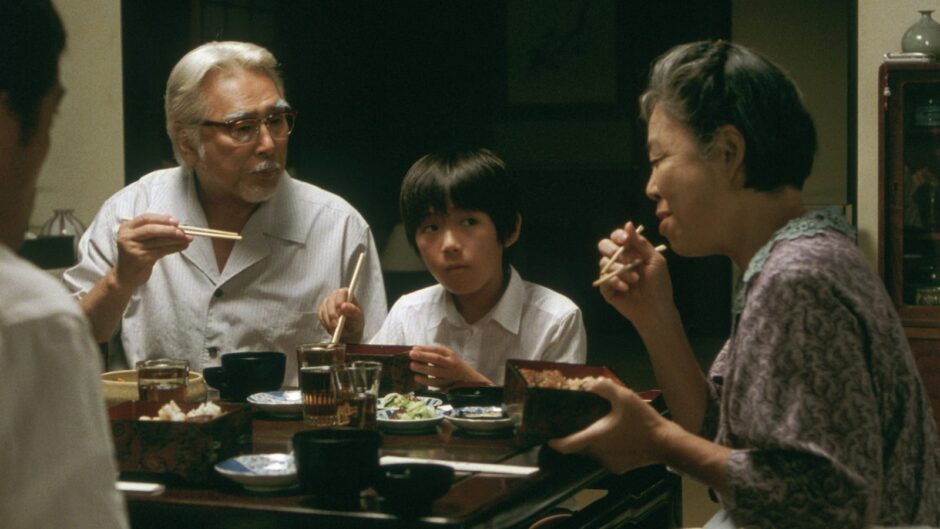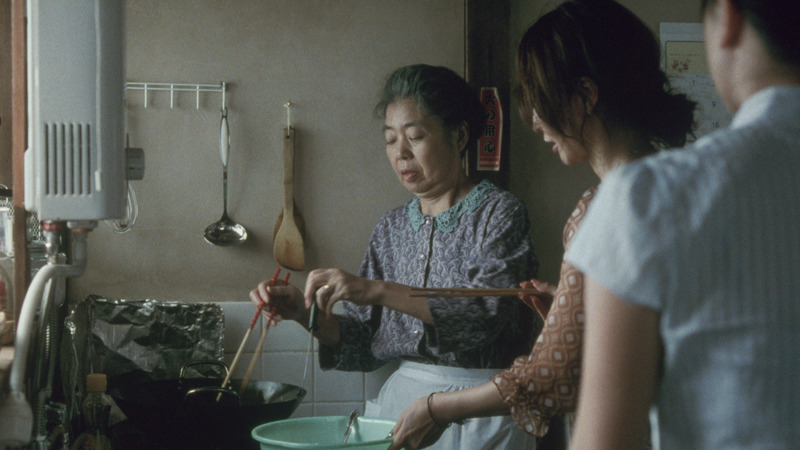analysis
The U.S. Criterion edition of Japanese director Hirokazu Kore-eda’s 2008 film Still Walking includes in its packaging a small booklet of recipes titled “Cooking with Kore-eda.” “One of the most memorable ingredients of Still Walking is the food cooked and prepared by the Yokoyama family,” claims its preface. Brief recipes for four traditional Japanese dishes follow.
You will be happy to have them, for after finishing the film, prolonged and sensuous cooking sequences linger temptingly in the mind. The treatment of food in Still Walking’s American marketing materials shares certain features with its larger critical response in the West, where it has received widespread acclaim. English-language critics tend to liken the film to the “Japanese Golden Age” work of director Yasujirō Ozu, drawing through lines from his postwar home dramas to Kore-eda’s contemporary projects.
Not unlike the inclusion of traditional Japanese recipes in Still Walking’s Criterion release, these comparisons draw attention to the film’s cultural specificity, to its apparently Japanese character and lineage. Analyzing Kore-eda and his work in terms of Japanese culture and tradition has its place in criticism, but it has been privileged at the expense of two additional and equally valid approaches to the film’s culturality: one that regards Kore-eda’s personal connection to its characters, setting, and events as principally important, and another that looks at Kore-eda’s cinematic influences from a global perspective.
Kore-eda himself points in interviews to three overlapping areas of influence and reference—the individual, the cultural-national, and the global—and any comprehensive treatment of the film would need to address each. But this has been the exception and not the rule.

In an attempt to contextualize Kore-eda’s work for English-speaking audiences, film writers in Canada, the United Kingdom, and the United States often settle into a kind of touristic criticism concerned primarily with the difference between his films and those made in the West. The touristic critic takes on the role of cultural translator, marking the boundaries between films made here and films made there and pointing out the features that audiences should recognize as being peculiarly Japanese. In effect, they ask the reader to join them in attending to the filmic elements that they won’t commonly find in English-language cinema.
This rhetoric can be thoughtfully employed in writing about international cinema, so long as it is not privileged at the expense of a fuller and less crudely comparative treatment. When Western critics do lean too heavily into a film’s cultural specificity and take its supposed differentness for its most salient feature, their writing starts to resemble a travelog more than it does film criticism. Any attempt to translate the culture of a “foreign” people for an audience “back home” is problematic regardless of its medium. These rhetorical moves savor of exoticism and, when aimed at Japan, Orientalism.
It will be useful, then, to trace some of the common approaches to Hirokazu Kore-eda’s work by Western critics and to explore how they might reinforce myopic or monolithic representations of Japanese culture. In order to place these approaches in conversation with the director, and with Still Walking in particular, I will turn to Kore-eda’s published commentaries and interviews throughout.
When Western critics do lean too heavily into a film’s cultural specificity and take its supposed differentness for its most salient feature, their writing starts to resemble a travelog more than it does film criticism.
Roger Ebert writes in his 2009 review of Still Walking that “if anyone can be considered an heir of the great Yasujirō Ozu, it might be Hirokazu Kore-eda.” Critic Peter Bradshaw describes the film as a “family movie in the classic Japanese style” and a “variant to Ozu’s Tokyo Story.” When asked how he responds to being compared so frequently with Yasujirō Ozu, Kore-eda states in a 2015 interview with Bradshaw, “I, of course, take it as a compliment. I try to say thank you. But I think that my work is more like Mikio Naruse and Ken Loach.”
The affinity with Naruse is no surprise, as Naruse and Ozu both produced family dramas that influenced Kore-eda. But the claimed kinship with British Socialist director Ken Loach may raise some eyebrows. This connection to Loach runs contrary to the Western narrative that sees Kore-eda as heir to Ozu’s legacy, carrying the torch of the Japanese Golden Age of cinema. Kore-eda does liken himself to Naruse, another Golden Age director, which suggests that he sees himself at least partially in this light; but by identifying equally with Ken Loach, he stresses the fact that his relationship with the Japanese cinematic tradition makes up only one of a number of connections that have influenced his thought and career.
If Kore-eda does follow in the humanist tradition of classical Japanese directors of the past, he may equally follow in the humanist tradition of more recent, socially critical directors like Ken Loach. In other words, his place in the world of film cannot be exhausted by just one point of reference. Whereas critics like Ebert situate Kore-eda nationally, Kore-eda situates himself globally, so that his national and personal influences may be viewed in conjunction with influences from England, the United States, and elsewhere. His words in the aforementioned interviews serve, then, as a kind of rebuff to critics who regard the director too narrowly.
Kore-eda’s claimed kinship with an English director, and the fact that he premiered his first non-Japanese language picture in August 2019, may help to dissuade Western critics from rooting the filmmaker too firmly in his home country. Still, one who looks into the history of English language writing on Kore-eda and his films must contend with several years’ worth of criticism that does exactly this.
In his aforementioned film review, Bradshaw said Still Walking was “unlike family dramas as conceived of in British or American drama” in that it featured no loud arguments between characters. The claim may have some foundation, but it nevertheless treats Japanese drama films and English language drama films as monoliths. Bradshaw sets Kore-eda over against British and American directors who also depict families but, the argument goes, do so loudly. In keeping with the trends of Kore-eda criticism, he then calls on Ozu for backup, suggesting that the Japanese dramatic tradition to which both filmmakers belong is essentially restrained, “quiet, undramatic.”
We may well agree that Kore-eda’s works are sober and emotionally reserved, but these traits indicate directorial (not cultural) specificity, and so they should not be used to place Still Walking in opposition to such broad categories as British and American drama. This is to mistake the film and its director for cultural ambassadors, sent abroad to offer other nations a representative sample of Japanese cinematic flavor. Critics should resist interpreting any cultural artifact in this way. The more one tries to typify something in terms of its country of origin, the greater the risk of exoticism.

Now, I don’t mean to say that writers who focus on Still Walking’s cultural specificity do so without any justification. It is, after all, a Japanese film, and Kore-eda has not shied away from identifying parts of his work as being characteristically Japanese. In a 2009 interview with Flavorwire, he describes the anti-confrontational philosophy of Still Walking’s characters as something “common to all Japanese people” for whom it is “a kind of wisdom, a way to survive, to keep a family going.” The absence of open confrontation from the film, as noted by Bradshaw, may indeed set it apart culturally and formally from the dramas of other countries, but Kore-eda himself unsettles this generalization in the same interview. “I thought I was portraying a very domestic, very Japanese home life and that it would be received by other cultures as incomprehensible, and that the [West] would criticize this as not pursuing growth,” the director says. “But people in France, Spain, New York, and Toronto — everyone says it reminds them of their family. I’m actually very surprised that Western audiences would perceive it as similar.”
Yes, countries as diverse from Japan as Spain and France have not only enjoyed but identified with Still Walking’s depiction of family. This is not to sap the film, which Kore-eda considers his “most Japanese” work, of all cultural particularity, but to show that particularity does not mean exclusivity or insularity. Western audiences have shown that they can engage with and relate to Kore-eda’s work in such a way that leaves its status as “foreign” or international cinema somewhere in the background. To watch Still Walking and be reminded of your own family is to engage with the film personally, and to leave behind the touristic approach and its obsession with difference.
If we reject exoticizing, touristic criticism, we can still engage with Still Walking in its particularity: as the product of a place, a time, and perhaps most importantly a person. Returning to his interview with Flavorwire, Kore-eda highlights his personal connection to the film several times, stating: “My intention was to portray my own family,” and, “I wrote [the script] right after my mother passed away.”
In another interview, he reveals that the Still Walking script was the result of the notes he and his sister took as they conversed with their dying mother. The film grew out of the feelings and memories of these two siblings, with Kore-eda—who worked on the film as writer, director, and editor—taking the helm. It cannot then be said that the film is at all representative of the Japanese experience, as some critics seem to believe, for it represents only a Japanese experience: that of the filmmaker and his family.
To watch Still Walking and be reminded of your own family is to engage with the film personally, and to leave behind the touristic approach and its obsession with difference.
Asked yet again about the lack of confrontation in Still Walking, Kore-eda says in the same interview, “It’s basically a social rule that you don’t say what you mean to the person that you feel [tension with], and that’s true of my mother, of me, and of most of the people around me.”
The director does not, as he does in his interview with Flavorwire, extend this social rule to “all Japanese people,” but stops with those in close proximity to him. He avoids making too broad a generalization and instead localizes his experience to a space more personal than national-cultural. Still Walking can be read richly with this intimate particularity in mind.
Even the recipes included in its U.S. Criterion release belong in some sense to a local family tradition. The dishes are, after all, based on recipes from Kore-eda’s mother and might not resemble those prepared by other Japanese families in other parts of the country. Kore-eda’s remarks on his personal connection to the events and characters of Still Walking invite viewers to attend to the film’s individual and familial particularity, rather than taking it for a representative of Japan as a whole.

Of course, Western writing on Still Walking hasn’t entirely missed the mark, and I don’t mean to claim that it has. Critics like New York Times contributor Dennis Lim have talked about the film without lapsing into touristic modes of analysis or drawing clumsy through lines to Japanese Golden Age directors. Lim weaves personal, national-cultural, and global lines of inquiry into his 2009 review, touching on a number of the issues addressed above (e.g. Kore-eda’s surprise at the film’s warm Western reception and the problematic nature of the frequent Ozu comparisons, among others).
He devotes the bulk of the article to exploring Kore-eda’s personal connection to the film, drawing heavily on relevant quotations from the director. As part of this focus, he works to place Still Walking in the context of Kore-eda’s filmography rather than in an oversimplified idea of “Japanese cinema”—an umbrella that covers some hundred years of film history and many more directors than just Ozu and Naruse. Lim seems to accept Still Walking on its own terms, offering a more nuanced reading of the film than those who set it over against English-language cinema (which is a complicated and non-monolithic category in its own right). There are no cultural generalizations to be found here, and the review is better for it. When Lim does mention Kore-eda’s kinship with Ozu, he does not stop after making the connection. Instead, he uses the connection as a jumping-off point from which to contrast the two filmmakers’ conceptions of character. “While Ozu’s characters are paragons of calm acceptance in the face of life’s cruelties and disappointments,” Lim writes, “the characters in Still Walking are pricklier and less reconciled, and they have a harder time concealing their resentments.”
It is rhetorical moves like this that make Lim’s review a model for other Western writers entering the Kore-eda conversation. But enough in the way of criticizing critics. I have tried to show how English-language writing on Still Walking privileges certain features of the film—those that signal Japanese cultural particularity—at the expense of others. Kore-eda’s own comments about his global web of influences and personal connection to his work remind us that elements of the film that seem to be characteristically Japanese may not be. Exceptions notwithstanding, there is a need for more English-language treatments of Kore-eda’s work that take this complexity into account.
I would like to offer a brief reading of Still Walking’s depiction of food that follows along these lines. While much has been said about the film’s representation of family, its representations of food and cooking have drawn comparatively little attention. When Kore-eda speaks in interviews about the film, his personal connection to its characters, and his surprise at its reception in the West, he does so primarily in terms of family. So when he says that reactions to Still Walking have been “more or less the same, whether in Europe, America or Japan,” and that audiences “laugh in the same places, cry in the same places, and…ask the same questions,” we gather that he is describing the audience’s response to the film’s centerpiece—the Yokoyama family. The food that brings the Yokoyamas together for meals and conversation, however, remains somewhere in the background.
Still, in the film itself, food often takes center stage. We see lingering close-up shots of fried corn tempura, pork belly kakuni, and colorfully garnished kinpira daikon. (You stop wondering why the Blu-ray includes a recipe book once you see these incredible dishes onscreen.) If viewers across the world have seen Still Walking and were reminded of their own families, how might they respond to its cuisine? Rather differently, I think, for while the film’s family dynamics involve a kind of human universality, its foods are more culturally and familially rooted. To those unfamiliar with the regional Japanese dishes prepared by the Yokoyama matriarch, the food of Still Walking may stand out as its most alien element. The inclusion of the recipe book in the U.S. Criterion release seems even to say, “Here, you’ve probably never cooked meals like these before.”

Food, so often a means of “sampling” another culture, marks the boundaries between what is local and what is far from home. Still Walking’s cooking scenes and its recipe book thus invite viewers unfamiliar with tempura and kinpira to engage with the film’s visual feasts touristically, as though they were visiting a so-called foreign restaurant that had opened in their hometown.
But if the food of Still Walking does not evoke a basic, shared response among global audiences, its function for the Yokoyama family likely does: the dishes prepared become a means to provoke memories, to close relational distances, to bring a family together in spite of the rifts between members. These byproducts of food and eating can’t be limited to any one cultural experience, but occur wherever meals are shared among loved ones. Kore-eda draws on his childhood and his mother’s recipes to show how food might bring a family much like his own together. In doing so, he asks viewers to recall dishes that they and their families feel personally connected to, and that function similarly to those in the film. And so the role food plays in Still Walking, that is to reunite and harmonize the family unit, offers another way for non-Japanese viewers to relate to the film regardless of cultural divides.
Curated by humans, not algorithms.
© 2024 A Good Movie to Watch. Altona Studio, LLC, all rights reserved.